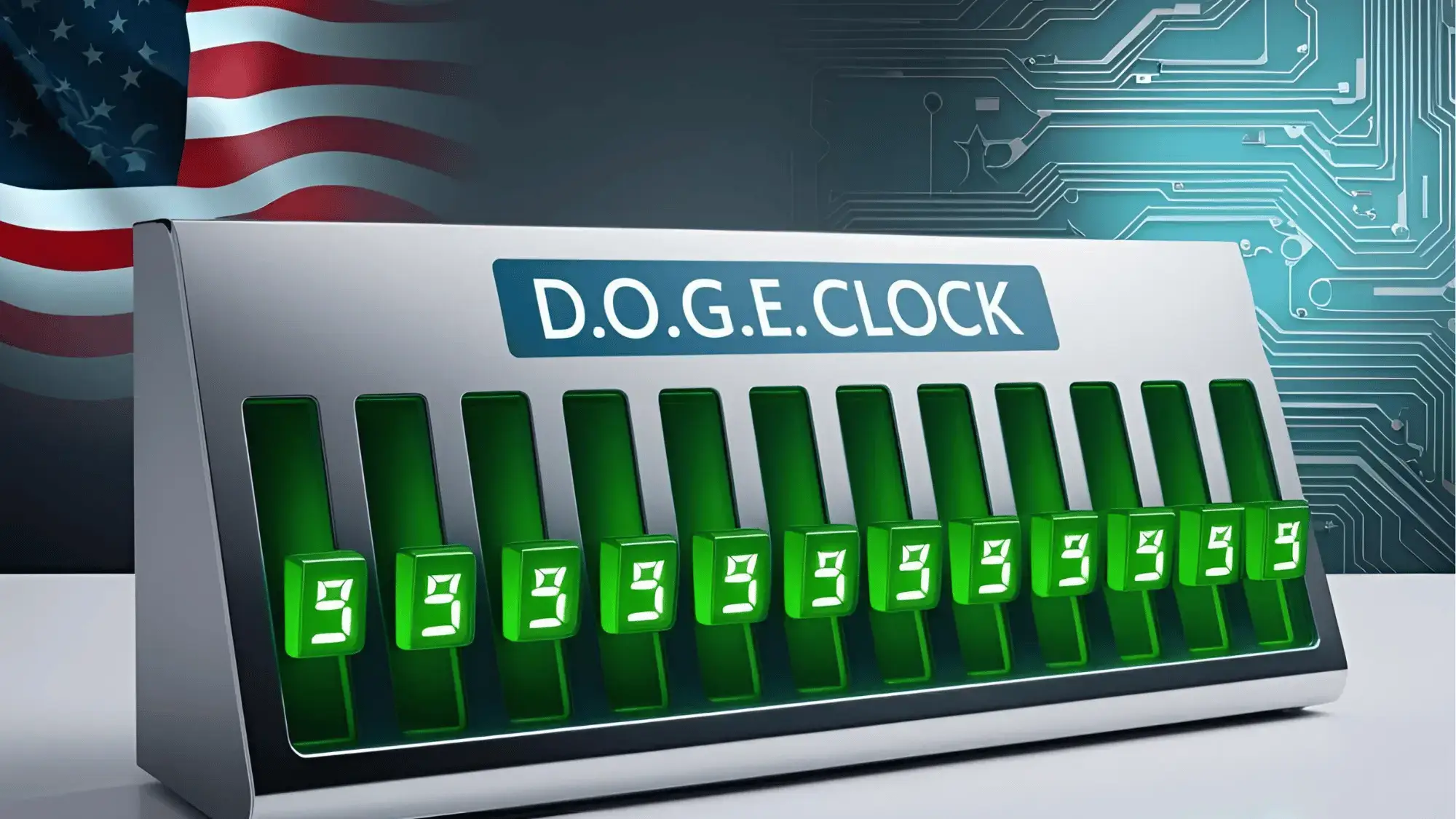Table of Contents
You might have heard whispers or seen mentions online, perhaps even noticed a curious addition to the US Debt Clock website sometime back: the “Doge Clock.” It sparked intrigue, confusion, and debate. But what is the Doge Clock, really? Is it a serious fiscal tool, a meme-inspired gimmick, or something else entirely?
Let’s clear the fog. The Doge Clock is a conceptual, real-time tracker, often linked to Elon Musk, intended to symbolize potential taxpayer savings achieved through increased government efficiency, specifically via a proposed ‘Department of Government Efficiency’ or DOGE. Since its emergence in the public eye around mid-2024, this idea, heavily promoted by Musk, aims to put a tangible (or at least, visible) number on the value of cutting bureaucratic waste. This guide will break down everything you need to know about the Elon Musk Doge Clock, explaining its origins, purpose, controversies, and what the Doge Clock represents in the broader conversation about government spending.
What Exactly is the DOGE Clock?
At its core, the Doge Clock explained simply is a visual representation – a running counter – designed to show, in real-time, the amount of money supposedly being saved by hypothetical improvements in government efficiency. Think of it like the famous National Debt Clock, but instead of tracking mounting debt, it’s meant to track accumulating savings achieved by streamlining government operations.
The stated purpose is straightforward: to highlight the potential financial benefits of reducing bureaucracy and waste within government agencies. It serves as a constant, visible reminder of the taxpayer savings that proponents, chiefly Elon Musk, believe could be unlocked. The idea posits that if a dedicated entity – the proposed Department of Government Efficiency (DOGE) – were implemented, this clock would quantify its success. Musk is the primary figure associated with championing both the DOGE department concept and the Doge Clock as its symbolic metric.
The Origin: Where Did the DOGE Clock Idea Come From?
The concept didn’t appear in a vacuum. It stems directly from Elon Musk’s long-standing public focus on efficiency, often drawing parallels between perceived government sluggishness and the lean, agile operations he strives for in companies like SpaceX and Tesla. Musk has frequently voiced opinions on reducing governmental overhead and bureaucracy.
The idea gained significant traction in 2024 when discussions around a potential “Department of Government Efficiency” (DOGE) intensified, particularly in circles associated with potential government reform under figures Musk supports. The Doge Clock emerged as a tangible, easily graspable symbol for this initiative – a way to market the idea of fiscal responsibility and bureaucracy reduction. Its notable appearance on the widely recognized US Debt Clock website significantly boosted its visibility, leading many to ask, “What is the Doge Clock?”
Decoding the Name: DOGE and its Meaning
The name “DOGE” is primarily an acronym for “Department of Government Efficiency.” This proposed agency, championed by Musk, would theoretically focus solely on identifying and eliminating waste across federal operations. The doge meaning government efficiency is central here.
However, the name inevitably evokes the “Doge” internet meme featuring a Shiba Inu dog, and by extension, the Dogecoin cryptocurrency. It’s crucial to address this potential confusion directly:
Is the Doge Clock related to Dogecoin? No. Despite the shared name, there is no known functional or financial connection between the Doge Clock concept (focused on government efficiency) and the Dogecoin cryptocurrency. The naming is almost certainly a deliberate, meme-inspired choice by Musk – known for his engagement with internet culture and Dogecoin itself – likely intended to make the concept more memorable, perhaps even viral. It’s a branding tactic, leveraging a familiar name for a new purpose.
How is the DOGE Clock Supposed to Work? (Acknowledge Speculation)
Here’s where things become less concrete, especially as of early 2025. Since the “Department of Government Efficiency” doesn’t actually exist, and the Doge Clock remains largely a conceptual or symbolic tool, there’s no official, established methodology behind its calculations.
- Known Methodology? None publicly detailed or verified. The numbers displayed (when it has been active) appear illustrative rather than based on audited savings.
- Potential Metrics? Proponents might suggest it could theoretically track savings from eliminated redundant positions, faster project approvals, reduced paperwork, optimized procurement, etc. However, defining and quantifying these efficiency metrics accurately in real-time across the entire government is an incredibly complex challenge.
- Data Source? Purely conceptual at this stage. A real version would require complex data feeds and agreed-upon formulas that do not currently exist.
Therefore, it’s best understood not as a precise accounting tool, but as a symbolic gesture – a visualization of a goal rather than a reflection of current, verified reality. The doge tracker savings are, for now, hypothetical.
Is the DOGE Clock Official or Symbolic?
As of April 2025, the Doge Clock is not an official government metric or tool. It hasn’t been commissioned, endorsed, or adopted by any official US government body. Its appearance on the US Debt Clock website was seemingly hosted or displayed by the private entity running that site, not integrated as an official government statistic. The visual presentation, as discussed in analysis like the one found on ApexWeb3 regarding the Doge Debt Clock’s appearance, further highlights its nature as a distinct, likely third-party addition.
Its current status remains primarily promotional – a tool used by advocates like Musk to popularize the idea of the DOGE agency and the broader theme of government reform. Think of it as part of a political commentary toolkit rather than a piece of official fiscal infrastructure.
For further information, you can visit the US Debt Clock website, where the DOGE Clock is featured: usdebtclock.org
Reception, Controversy, and Criticism
The Elon Musk Doge Clock concept has drawn mixed reactions:
- Arguments For (Potential):
- Focus on Waste: Supporters argue it brings much-needed attention to government waste and the importance of taxpayer savings.
- Transparency Goal: It represents a push for greater fiscal transparency and government accountability.
- Motivation: A visible metric could theoretically motivate efforts towards bureaucracy reduction.
- Arguments Against / Criticisms:
- Gimmickry: Critics dismiss it as a simplistic gimmick or political commentary tool, oversimplifying complex issues.
- Lack of Substance: The absence of a clear methodology or real data makes the displayed “savings” arbitrary and potentially misleading.
- Oversimplification: Reducing government efficiency to a single, running number ignores the nuances and necessary functions of public administration.
- Political Tool: It’s seen by some as a tool to promote a specific political agenda or critique existing administrations.
- Feasibility of DOGE: The underlying concept of a separate DOGE agency is itself debated, with questions about its potential effectiveness, cost, and overlap with existing oversight bodies (like the GAO or O M B).
The Bigger Picture: Government Efficiency and Musk’s Role
The debate around the Doge Clock taps into a perennial issue: how to make government more efficient and less wasteful. Concerns about national debt and the value derived from taxpayer savings are widespread. Various proposals for fiscal responsibility emerge regularly, reflecting different political and economic philosophies. For instance, ideas range from targeted cuts to broader reforms like the Trump proposal regarding income tax and Bitcoin, highlighting the diverse approaches considered.
With his background in disrupting industries (spaceflight, automotive) through aggressive efficiency drives, Elon Musk brings a unique, often polarizing perspective to this conversation. His advocacy for DOGE and the Doge Clock fits his pattern of proposing technologically-flavored, metrics-driven solutions to large-scale problems, whether they are ultimately practical or a more symbolic representation of an ideal.
Conclusion: What the DOGE Clock Represents
So, what is the Doge Clock in the final analysis? As of early 2025, it remains more of a potent symbol than a practical instrument. It successfully generated conversation and brought attention to Elon Musk’s proposals for tackling government waste through a dedicated Department of Government Efficiency clock. It embodies a desire for quantifiable results and taxpayer savings.
However, without a concrete framework, verifiable data, or official status, its primary function is currently as a piece of political commentary and a promotional device for the DOGE concept. Whether it evolves into something more substantial or fades as a novelty depends on the future trajectory of the proposed DOGE agency itself and the broader political landscape. It serves as a fascinating case study in how modern communication, meme culture (doge meaning government efficiency, in this case), and high-profile advocacy intersect with complex issues of governance and fiscal policy.
Frequently Asked Questions (FAQ) About the DOGE Clock
How does the Doge Clock work?
Conceptually, it’s meant to track savings from government efficiency in real-time. Practically, as of 2025, it lacks a defined methodology and uses illustrative numbers.
What is the DOGE clock used for?
Primarily, it’s used as a symbolic tool to promote the idea of a “Department of Government Efficiency” (DOGE) and highlight potential taxpayer savings from reducing waste.
What is the meaning behind DOGE?
DOGE stands for “Department of Government Efficiency,” a proposed agency championed by Elon Musk.
Is the Doge Clock official?
No, the DOGE Clock is not currently an official government initiative. It’s a private project associated with Elon Musk’s advocacy for government reform.
Who created the Doge Clock?
The concept is strongly associated with and promoted by Elon Musk, linked to his proposed DOGE agency. The actual implementation (like its appearance on the US Debt Clock site) involves the entities hosting it.
What does DOGE stand for (in this context)?
Department of Government Efficiency.
Is the Doge Clock related to Dogecoin?
No, aside from the likely intentional use of the meme-related name, there’s no functional connection to the cryptocurrency.
Where can I see the Doge Clock?
It notably appeared on the US Debt Clock website. Its current visibility may vary. There isn’t one single “official” place to view it, as it’s not an official tool.
What are the criticisms of the Doge Clock?
Critics call it a gimmick, point to its lack of real data/methodology, argue it oversimplifies efficiency, and see it as a political tool.
What are your thoughts on the DOGE Clock? Is it a useful symbol or a misleading distraction? Share your opinions in the comments below! Don’t forget to share this post if you found it informative.





